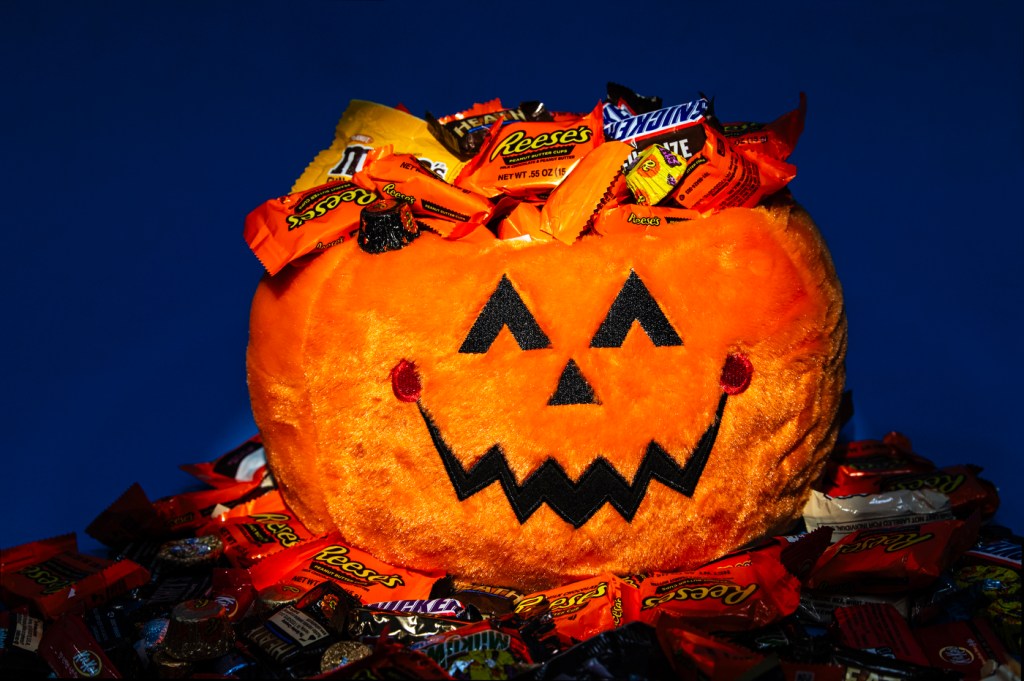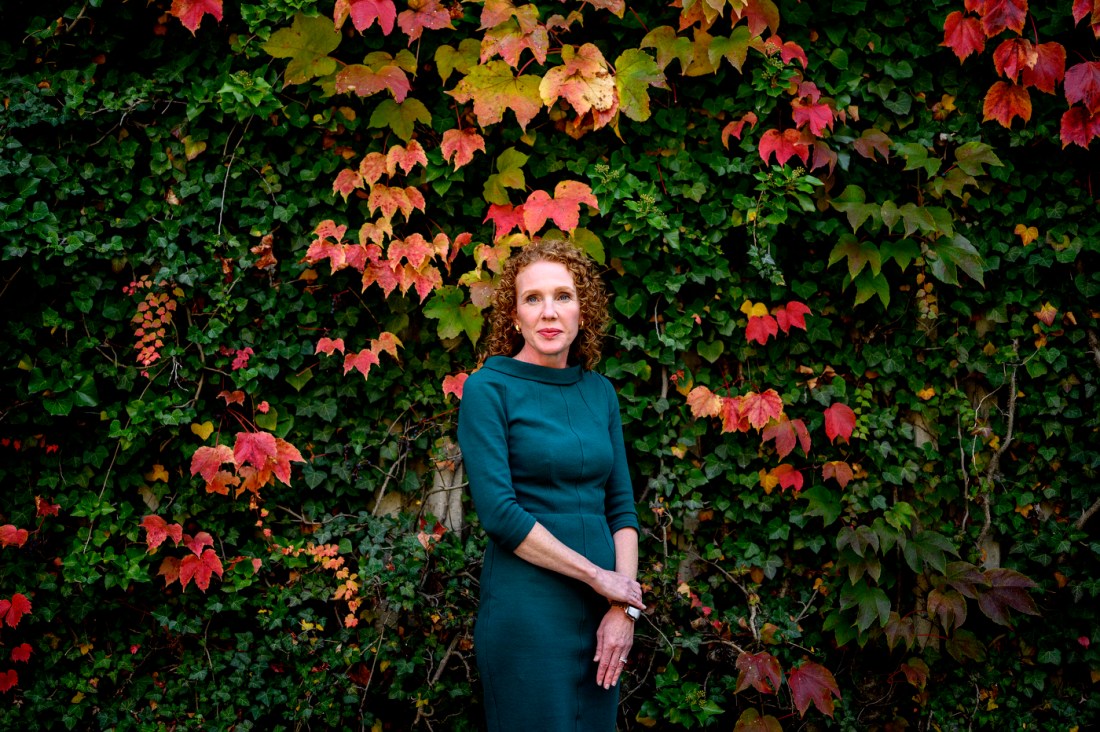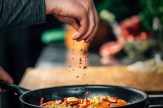Trick-or-treating can be a food allergy nightmare. Five tips to help kids take control — beyond teal pumpkins
Northeastern psychologist Jessica Edwards George specializes in counseling kids and families with food-related disorders.

For most kids, Halloween trick-or-treating is a highlight of the year — their annual chance to go a little wild, stay up late, stock up and overindulge on chocolate, candy corn and Sour Patch Kids.
Children with severe food allergies and their parents, however, may experience the inverse of that sense of abandon. For families whose daily routines around food involve scoured food labels, curated pantries and careful planning, the spontaneity involved in trick-or-treating can be dangerous, stressful and discouraging.
“This is the holiday that children in the United States come together around, and the major aspect of it is food,” says Jessica Edwards George, an applied psychology professor at Northeastern University. “And there isn’t a candy that’s safe for everyone.”
Approximately 1 in 13 school-age children in the United States have at least one food allergy, according to the Centers for Disease Control and Prevention. And despite a huge increase in the prevalence of food allergies in the last 30 years, many of the most popular Halloween candies still contain at least one, if not several, of the most common allergens, including nuts, eggs, dairy and wheat. Because many are manufactured in the same facilities — then thrown together in the same household bowls — simply checking ingredient lists does not always guarantee safety.
According to one study, allergic reactions to peanuts and tree nuts spike as much as 85% on Halloween.
Edwards George is a clinical child psychologist who specializes in food-related illnesses and disorders; she also has two children with severe food allergies. In addition to the heightened physical danger Halloween can present, she notes, there are a range of mental and social difficulties.
“There are the feelings of exclusion — feeling reluctant to participate or uneasy to participate,” she says.

But at the same time, she thinks Halloween can be a useful occasion to teach kids to advocate for themselves and navigate tricky situations they will face in other contexts as they grow older. These are her expert tips for families, neighbors and communities to make the holiday safe for everyone — and loads of fun.
1. Make a plan
According to Edwards George, the most surefire way to do this is “having conversations about it ahead of time, anticipating what the potential challenges will be, and not making in-the-moment decisions that could result in hurt feelings or physical illness. That [should happen] before the costume goes on and the kid walks out the door.”
That can take different, developmentally appropriate forms depending on the kid. For younger children, a visual list of candies to seek out and avoid, as well as some general rules — kids with peanut allergies should usually avoid fall colors like yellow and orange — can help mitigate the chaos “when there’s a bunch of other kids behind you waiting to get their candy.”
Older kids can check ingredients, but “don’t eat anything while you’re out. You’ve got to get home to read the label in the light,” Edwards George says.
She also recommends reassessing the plan every year, and adjusting as needed as kids grow and develop. “What worked? Where were the hiccups? How can we do it a little bit differently next year?”


2. Don’t rely on teal pumpkins
As food allergies have become more pervasive, efforts to spread awareness of the problem around Halloween have grown. The most recognizable is the Teal Pumpkin Project, which encourages people handing out Halloween candy to offer non-food goodies in a separate container.
While very helpful, Edwards George says it isn’t an end-all solution. “I mean, that’s part of it — do we make holidays free candy and food?” she says. “That’s a hard thing to do in the context of the way our culture is focused around food. And I think sometimes kids don’t want to be the reason why everybody else can’t have the candy.”
So in addition to looking out for those markers of safety, she recommends:
3. Give kids a script
Edwards George says Halloween can be a valuable opportunity to work with kids on how to ask for what they need. It’s a skill “that applies to food allergies as it applies to a lot of other things in life,” she says.
Featured Posts
“I like to think about ways that we can give kids some agency around these situations — having a script saying, ‘I have a peanut allergy. I’m wondering if you have anything that’s safe for me.’ You can practice that language and role-playing before you get to the door.”
She says that type of interaction “parallels a lot of different challenges that [require] assertiveness — the ability to ask for what you need and say no to the things that you can’t have or you don’t need. It might apply to bullying and teasing, or agency of one’s own body. It’s a skill that can be applied to any relationship.”
4. Pile on the praise
Thinking about people on the other side of the candy exchange goes a long way, Edwards George says.
“When individuals pay attention to kids with food allergies — understand it, make exceptions, figure out a way to make it safe — we should raise that up,” she says. “We want individuals to generalize that to other kids too, not do it just because they personally know my child has a peanut allergy.”
She encourages her own kids to dole out a lot of praise. “I’ve worked with my kids to really jump on it and reinforce the individual,” she says. “Like, ‘That’s amazing that you have those treats that are safe for everybody. Thank you so much for thinking of us.’ And even after the fact, coming back to say, ‘That meant a lot to our family for us to be able to participate in a safe way.’”
5. Make new traditions
After trick-or-treating, Edwards George hosts a neighborhood candy-trading party where kids with different food allergies — or not — can get the treats they want and need. Over the years, it’s become a bigger highlight than the actual trick-or-treating.
“It’s amazing to watch them make sure everybody gets covered,” she says. “The kid with an egg allergy might be able to eat one thing, and the one with a peanut allergy can’t. So there’s a negotiation, with some adult supervision depending on the age, where everybody walks out feeling really good. Like, ‘I got all the Skittles that I wanted, and I was able to make sure my friend had what they could safely eat.’”
She recommends incorporating other routines that can make food restrictions a holiday feature, not a bug: exchanging candies for nickels and dimes, trading all restricted candies for a bigger toy, or donating discarded treats to a local charity.
Above all, the key is listening and being responsive to the needs of each kid. Due to anxiety or other reasons, they may not want to participate at all. And that’s OK, too.
“It really is individual- and family- and community-based,” Edwards George says. “There are different ways to navigate it.”











